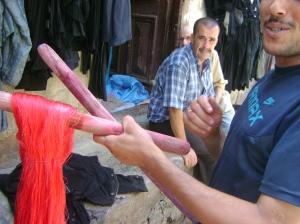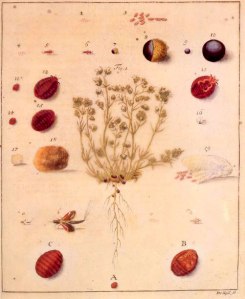There was a time when color was worth crossing the Sahara for. It drove men to risk life or scurvy to bring back logwood bark from across the Atlantic, or swim under the surface of the sea to harvest unearthly colors. Far-flung villages became famous for the luck of having a plant or beetle that could produce a dye like no other. Travel the world over, and the color souvenirs were truly things of wonder: a black of a somberness never before seen in Europe, or a purple so deep it was too rich for even the Empress of Rome.
Red dyes in vats that have been around since the 1400s. Fez, Morocco.
The first natural dyes were suspiciously akin to food stains: yellow turmeric, orange saffron, red annatto and rosy-pink safflower. It’s easy to imagine the accidental discoveries — turmeric dribbled down the front of your drab beige tunic didn’t wash out, but brown beef stew did. More than just stains, the colors of these ground plants formed a chemical bond with the fibers of the cloth.
Never content with what chance gives us, humanity, across cultures and over millennia, tried to find ever more substances that could dye cloth, and do it better. Besides color, “fastness” – the ability of a dye to maintain its color without fading or washing away — was key. The discovery and perfection of the use of mordants — binding agents that improved the fastness of a dye, and in some cases influencing the very color produced — became a science in itself. Recipes and techniques for the best dyes spread with the fame of the cloth.
Along the cross-continental trade routes, people went mad for the rich, bright blue of true indigo, a flowering plant harvested and processed in India, Vietnam and parts of sub-Saharan Africa.
The people of Tyre, in modern-day Lebanon, somehow discovered that the mucous secretion from the hypobranchial gland of a predatory Mediterranean sea snail made an excellent purple. There are two ways to extract the luxury mucous: by gently milking the snail (and letting it live another day for another milking), or by crushing the snails and draining out the liquid. Twelve thousand snails yielded 1.4 grams of pure dye — enough for one garment. Whether carried out by an army of milkmaids or by snail harvesters, the process was painstaking. But Tyrian purple had a quality like no other dye — it didn’t fade or dull, but became brighter and more intense with sunlight and use.
For centuries, until the fall of Constantinople in 1204, Tyrian purple cloth was the mark of royalty. While the dye-ing techniques were lost forever in the ravages of the Fourth Crusade, in a couple of centuries discoveries from the New World would capture people’s devotion.
When crushed, gray cochineal beetles from Central America turned orange with a base mordant, purple with an acid and burgundy with neutral water. But the dye discovery that truly transformed clothing — at least in the eyes of this writer, the Spanish clergy, and generations of men and women of certain dispositions — is the fast black of the flowering logwood tree of Belize.
NATURAL VS. SYNTHETIC
Like many bad choices of the past, low prices and convenience drove the drift from natural dyes to synthetic ones. The first synthetic dye, discovered accidentally by chemist William Henry Perkin in 1856, was mauve. Though it has never been a crowd favorite, chemists saw its potential, and set about developing other colors. Synthetic dyes were much easier to manipulate, producing clear, brilliant tones. Natural dyes still lasted longer on the cloth when exposed to water and light, but convenience won out, and by the early 1900s natural dyes had almost entirely fallen by the wayside.
 Dyer-masters from street sbariin, Fez medina.
Dyer-masters from street sbariin, Fez medina.
Today, it would be wrong to suggest that with a century of advancements and innovations behind us, synthetic colors are inferior to natural dyes. Some metal mordants (dioxin and formaldehyde, for example) can be environmentally harmful, but even natural plant dyes use heavy metals like copper and alum. If you’re worried about safety, food-grade dyes will always be safest. (Though you’ll need to research each one to guarantee the safety of a dye.) There’s still a range of quality when it comes to synthetic dyes; cheap ones will fade with each wash, while others are as resistant to light exposure and repeated washing and are as good as or better than their natural counterparts. –
See more at: http://kaufmann-mercantile.com/natural-dyes/#sthash.XaDntz6d.dpuf













Leave a comment